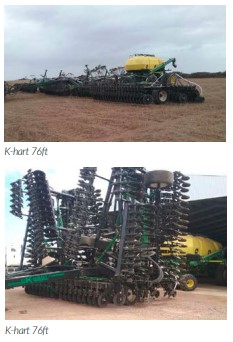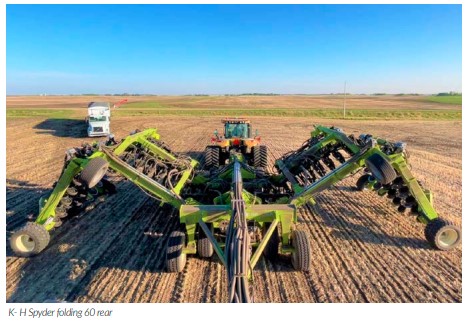Written by Tony Gent
With over 60 years of farming, I have seen and been involved with so many changes, as a lad from working with horses and leaving school at 15 to working on my father’s smallholding with only 50 acres and a mix of cropping. The farm began to mechanise and expand, so did my interest in designing better tools, particularly to improve soil management. The need to produce crops in an economic and competitive way has always been my driving force, with the sustainability of the business as well as ecology and the environment.
We first started to notice the importance of soil condition in the 1960s, with taking on heavy distressed soil which was suffering from poor cultivation techniques, resulting in pans and compacted layers. Having mastered those problems it became obvious that moving soil around was not only complex and expensive, but the soil workability was deteriorating and more liable to slump, cap and puddle.
At that time larger more complex machinery was becoming available and seen as a major part of the solution. To take advantage of larger tractors, particularly tracklayers with threepoint linkage and larger 4-wheel drive in the 70s my first development was what became known as the “Wilder Pressure Harrow”, my own design of harrow which was manufactured and marketed by John Wilder Engineering. This consisted of ground following individual units mounted on a parallel linkage, pressurised by a floating hydraulic down force and tines that could be infinitely adjusted. This allowed the scrubbing frame to achieve a precise seed bed for both spring use, on overwintering ploughing and on heavy tined cultivation in the autumn. The Pressure Harrow was awarded a silver Medal at the Royal Agricultural show in 1977 for machinery innervation.
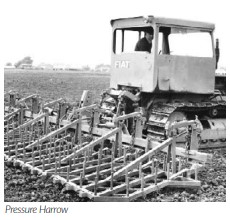
With much more emphasis on autumn crops, especially oilseed rape and September establishment of wheat, the Pressure Harrow became invaluable for scratch tillage that was widely adopted. However, to fight soils that were in a poor structural state causing rooting and drainage problems a means of lifting and shattering the soil with minimal surface disturbance was needed. Together with Ken Taylor a local agricultural engineer a low disturbance subsurface tine was developed. This featured a slender point and front shin together with large wings to shatter the soil with a wide lateral effect, allowing wide tine spacing. It achieved the effect of loosening all the soil with no layer mixing or bringing unwanted soil to the surface. It became known as the “Flat Lift”
Demand for this method of low disturbance soil loosening coincided with larger horsepower, mostly American, tractors becoming available and to meet the demand for the Flat Lift an engineering company was founded to manufacture and to market it, an agreement with Parker Farm equipment was put place with the product being known as “Parker Farm Flat lift” manufactured by Taylor-Gent Engineering. However, as others adopted this approach competition from more established companies became intense, and as a small specialist manufacturer it was not viable. The rights to the product were acquired by Spalding’s, who still market it as the original “Flat Lift”
There was no-doubt we were on the right lines with all this. However, the whole process had to change as attitudes to straw-burning changed in the early 90s. We had become experts at this, using combines fitted with spreaders to achieve a 100% burn, completely obliterating trash with no chemical help such as glyphosate. However, as autumn cropping became more common, the intensity of the burn inevitably led to straw-burning being banned, and it almost seems incredible now this practice lasted so long. Although we now realise what we thought was an idyllic situation, but with the first signs of chemical resistance creeping in especially with black grass and brooms we now realise this was an unsustainable situation.
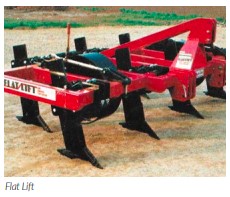
The straw burning ban was a massive game changer, as we were growing lots of second and third wheats that were early drilled, producing high volumes of straw to deal with. We had to revert to moving soil around with some inversion or mixing to bury or at least incorporate the straw to some degree. This caused a massive reinvestment in machinery and power to rapidly recover aggressively moved soil into a suitable seedbed in a very short time.
During this period, we took advantage of land becoming available with rapid expansion in acreage. Much of this was again soil in a distressed state requiring lots of TLC. Also, with the new FBT and contract farming arrangements with strong competition the rents tendered subsequently proved to be far too high. We had no choice but to invest in lots of power and big soil moving and drilling kit. Due to our limited cash resources and our ability to mend and make, this was done with a focus on quantity rather than quality. At the end of this period, we owned 3 CAT Challengers and a full set of the kit to utilise them that was rapidly becoming very tired.
Into the 2000s now farming a large area, costs were rising, and we were in a period of low commodity prices with wheat as low £60 to £70 per ton and locked into historic rents that were proving unsustainably high. This all came to a head in the years 2004 to 2008 when we knew we would need to re-invest in newer machinery. Given the intense workload and poor margins, with no prospect of improvement this seemed a questionable investment and caused us to re-evaluate what we were doing.
It was at this time I had a chance coming together with the UK No-till pioneer Tony Reynolds. I was NFU County Chairman and he became my Vice Chair. Many of our NFU meetings would end in discussion around soils, much to the disquiet of some. This resulted in several visits to his farms to get an understanding of what he was doing and above all to tap into his knowledge and experience and gain confidence to try it for ourselves. Subsequently also becoming involved with experiences of the Europe wide ECAF (European Conservation Agriculture Federation) which he is part of.
We began to move towards a change in 2007 with the first wheat being established with the Vaderstad Rapid drill after a light scratch to allow the conventional light discs to penetrate undisturbed soil. This first year with wheat it was a success and very encouraging. We also attempted oilseed rape sowing with a hired Bertini drill into a heavy surface residue situation in wet conditions. This was a total failure due to slugs, hair pinning and toxin damage.
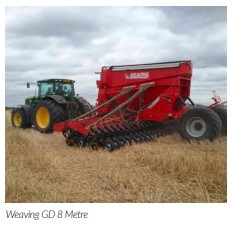
Drilling kit for No-till was somewhat limited at the time, and with our soil conditions resulting in producing large broken out clods with a solid tine and potentially high residue we felt we must stick to a rotating disc. The options were basically only Bertini or John Deere.
At that time, I was invited to Argentina to visit the Bertini factory in Rosario and attend the Expoagro Farm Show, where I found lots of Notill kit of various designs and creations, mostly very basic or locally specialist. It had the feel of being built in the farm workshop or by the local blacksmith, not at all to European standards except for a few more serious manufacturers like Bertini. Argentina was forced into No-till by economic pressures of direct commodity taxation forcing massive simplification with cultivations resulting in cost cutting. They had been advised that as result of this they would suffer approximately 20% yield loss, but the reality was after 5 years their yields were actually greater as a result of adopting Notill. Their perception, probably correct of Europe was that we were given so much financial support that we didn’t need to consider costs and we just wasted money on lots of complex kit with shiny new paint. I came home with what seemed to me a simple thought that if I pursued their logic of production methods, together with the benefit of the support it would be a win-win situation and basically that is what happened.
To make a solid start we needed to jump in, and the first necessity was a drill. Having seen both the Bertini and the John Deere in action, I liked the double disc system of the Bertini with its slender opening, low disturbance and so returning from Argentina I came close to placing an order for an 8 metre Bertini. However, considering that it was a box, end tow for transport drill and having experienced and seen its limitations in our wetter conditions thought better of it. So, to get us going a new John Deere 6 metre 750A was ordered for the 2008 autumn season to work alongside our team of Challengers and conventional 8 metre Vaderstad.
For this season all the rape was very successfully established, wheat direct drilled after Beans and some second wheat with the John Deere. With the second wheat we had an interesting and revealing comparison: our standard practice for a second wheat then was to plough followed by a press and then to aid weathering mostly the need for a second press with tines. At drilling three CAT challengers were in action with a primary seedbed cultivator, followed by a power harrow and then the 8 metre Vaderstad and then having to be rolled, 6 or 7 operations in total. I remember in one situation I was drilling a next field in the same rotational situation with one pass with a 150hp tractor and the new John Deere 750A. The No-till crop established well and became a robust crop and out yielded the conventionally established crop.
With this first year experience our direction became cast in stone from that point on and we began disposing of the now unwanted tractors and machinery, eventually resulting in the removal of a 1000hp from our system. By 2009 we were fully committed to No-till but in the subsequent years it was by no means plain sailing: and sometimes conditions weren’t exactly favourable, experiencing wet seasons and degraded soil that needed time to recover.
I felt that the compromise I had taken opting for a single disc drill was starting to show and began to reflect back to my observations with the Bertini double disc with much less disturbance of the opening and a kinder soil action. I became aware that Weaving Machinery were seeing opportunities in the No-till marketplace and revamping their Krause system into what became known as the Big Disc, of which we acquired an 8 metre version. It consisted of a double disc arrangement of a small disc running in the shadow of a larger disc thereby creating a very narrow opening, but the opening still had to be closed which was difficult in dry hard conditions and was only achieved by pressing and squashing in wet conditions. The problems were because of the unbalanced side pressures of large and smaller disc the rigidity of the linkage required the same robust construction that was needed with a single disc, and that was its failing which limited its effectiveness.
The breakthrough came with a passing comment from Tony Reynolds that if it was possible to cut into the soil at an angle to place the seed under a lip of soil it would be much easier to close the soil over the seed. The problem was how in practice to achieve this. My first indication of a possibility along these lines was becoming aware of the Canadian Saskatchewan “Barton Opener” which is a single angled undercut disc system. However, subsequent investigation found that it had limited minimal disturbance and seemed to have technical limitations with stability robustness.
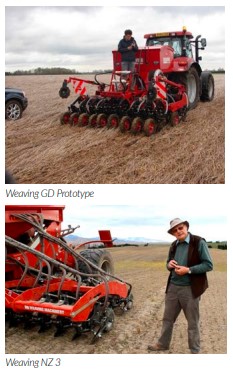
I began to realise that to achieve stability with a disc system, the force of moving soil to create an opening needed to be countered by a stabilising force on the same bracket. I began by taking the standard Weaving Big Disc arrangement and hinging it on an angled pivot to create a neutral trailing action. I then gradually increased the angle from vertical to approximately 20° to 25°. This achieved the undercut angle I was looking for with the smaller disc on the upper side creating a wave of soil flowing over it with the rotation forming an opening with very little soil disturbance, damage, or side compression due to the soil being gently eased upwards. The larger disc formed the initial soil cut, helping with a precise and slender opening for the seed. The main benefits are that an opening is created to place the seed in the soil without having to move the soil sideways, so there is no requirement to return the soil back to cover the seed. It was often described as like lifting the edge of a carpet and placing seed under it and it then returning to position covering the seed (see attached photo of an early demonstration unit)
Weaving Machinery quickly saw the potential of the system and a manufacturing and marketing deal was agreed and production began in 2015. The GD (Gent Disc) drill quickly became extremely popular in the UK, many European countries and subsequently New Zealand.
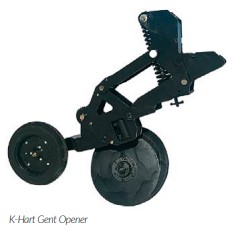
Later that year I visited Australia and picked up a contact I had made with the famed Bill Crabtree “No-Till Bill” in Western Australia. He introduced me to Darryl Hine of Direct Seeding and Harvesting based in Albany WA. Darryl was one the leading exponents of introducing No-till machinery to Australia and was the importer and agent for the Canadian K-Hart range of disc drills.
With introduction from Darryl, I then visited K-Hart at their premises in Saskatchewan, where I stayed for a few days with farmer and engineer Kim Hartman getting to know them and their product which was similar to Weaving’s and consisted of a conventional double disc system. We did some trials with some Weaving GD Units that had been sent to them, which they were impressed with and quickly saw the potential. Again, a deal for manufacture and marketing covering North America and Australia was put in place and with some redesign to adapt to their standard parts production began of the “K-Hart Gent Opener” in 2017, with modifications to the design to suit their conditions both in North America and Australia. I have subsequently visited both Canada and Australia to help with further design refinements and promotion of the opener where interest and sales are rapidly increasing. K-Hart has now evolved into an expanding company involving a new team to design and develop a specialist unique frame to suit the “Gent Opener” branded the “Spider” frame. These frames are up to (76ft) 24 metres wide which folds in 5 sections and have typically 100 to 130 openers.
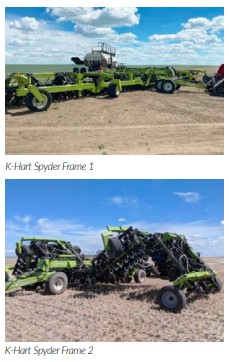
Our farm has now been No-till for 12 to14 years and we have absolutely no regrets. As envisaged in the early stages, it has been a win-win situation of lower operating and input costs with sustained or improved yields. We now have a more sustainable rotation and massively improved soil with organic matter levels that started at near nil now close to double figures on many fields. The release of capital also allowed the business funds to invest in the massive expansion of a fledgling enterprise on the farm of Free-Range Egg production.
The transition from an intensive high input to a low input and much more rewarding and sustainable system has been a very interesting and a rewarding journey. New benefits are now emerging, with the demise of subsidy support on the horizon, addressing climate change and carbon sequestration. This latter opportunity has now been identified as an additional income stream that can help support and encourage more farmers in adopting No-till, so again we have a win-win situation.
